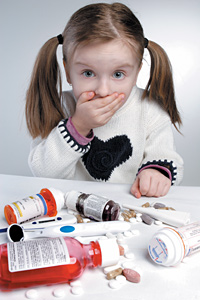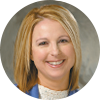With an increase in available diagnostics and the number of medications available to treat every possible disease increasing exponentially, it shouldn't be any surprise that the number of prescriptions being written for both adults and children has risen dramatically over the past several years.
Pill Overload
In December of 2010, The Wall Street Journal reported the latest findings by Medco Health Solutions Inc., which determined that roughly one in four children and 30 percent of adolescents between the ages of 10 and 19 are taking a medication for a chronic condition in the United States.1-2 Nearly 7 percent of children are taking two or more such drugs, according to the company's research.
Dr. Robert Epstein, chief medical officer at Medco, said that these results were "shocking" to the company.2 "While H1N1 caused a spike in antiviral use among children last year, the far more alarming trend since the beginning of the decade is the increasing use of medications taken by children on a regular basis and, in some cases, for conditions that we don't often associate with youth, such as type 2 diabetes."3
The total number of prescriptions or refills dispensed to children and teens (from most to least dispensed) is as follows:
- Asthma drugs: 45,388,000; children 0-9 years 28,252,000, children 10-19 years 17,136,000.
- ADHD drugs: 24,357,000; children 0-9 years 7,018,000, children 10-19 years 17,339,000.
- Antidepressants: 9,614,000; children 0-9 years 1,026,000, children 10-19 years 8,588,000.
- Antipsychotics: 6,546,000; children 0-9 years 1,396,000, children 10-19 years 5,150,000.
- Antihypertensives (treatment for high blood pressure): 5,224,00; children 0-9 years 1,819,000, children 10-19 years 3,405,000.
- Sleep aids: 307,000; children 0-9 years 14,000, children 10-19 years 293,000.
- Non-insulin-dependent (type 2) diabetes: 424,000; children 0-9 years 30,000, children 10-19 years 394,000.
- Statins (treatment for high cholesterol): 94,000; children 0-9 years 11,000, children 10-19 years 83,000.
 From statins to sleeping pills, it's clear that many of the drugs once considered necessary for adults only are being prescribed to children as well. IMS Health, a research firm, provided The Wall Street Journal with figures that confirmed this fact.1
From statins to sleeping pills, it's clear that many of the drugs once considered necessary for adults only are being prescribed to children as well. IMS Health, a research firm, provided The Wall Street Journal with figures that confirmed this fact.1
Researchers believe that this rise is being caused by doctors and parents becoming "more aware of drugs as an option for kids," but the problem remains that many of these drugs have not been tested specifically for the pediatric population.1 Danny Benjamin, a Duke University pediatrics professor, is specifically concerned about the well-established drugs since the pharmaceutical companies have no incentive to test them.
"We know we're making errors in dosing and safety," he said, and has suggested that parents themselves need to take the time to research any new medications suggested by their pediatrician. This can be done by reading labels, going to the FDA Web site, looking for published research at www.pubmed.gov and collecting clinical guidelines from groups like the American Academy of Pediatrics.1
A Growing Problem
It appears that the growing childhood obesity problem in the United States could be partially to blame for these alarming statistics. For instance, drugs used to lower cholesterol are taken by 10-19-year-olds at a rate 50 percent higher than a decade ago. The concern with this is that these drugs are associated with weight gain and an increased risk of developing type 2 diabetes; meaning that the cure could actually exacerbate the problem.2
Additionally, the researchers at Medco believe the obesity epidemic could be to blame for the greatest spike in prescriptions over the nine-year span considered in the report. There was a 147 percent increase in the number of children prescribed proton pump inhibitors, which are treatments for heartburn and gastroesophageal reflux disease (GERD).3
The Medco report noted, "The increases in prescription drug use by children for chronic conditions could fuel significantly higher health care costs as those young patients enter adulthood."4 However, perhaps the bigger concern should be that many of these drugs have not been tested and no research exists to tell parents what can happen when they are taken regularly from childhood into adulthood.1
Growing Concern
The Medco report also indicated that ADHD treatment use is on the rise, with 13.2 percent of the prescription drug benefit dollars spent in this area. However, the greatest concern could be the spike in use of atypical antipsychotics. Traditionally used to treat schizophrenia, these drugs have been recently prescribed to children for a variety of psychiatric disorders.
"Atypical antipsychotics are extremely powerful drugs that are being used far too commonly – especially in children – given their safety issues and side effects," according to Dr. David Musina, a specialist in mood disorders and national practice leader of the Medco Therapeutic Resource Center for Neuroscience. He further noted that they are being prescribed for depression and anxiety, "for which there is not good evidence that they are an effective treatment and yet we're exposing children to the possibility of extreme weight gain that could lead to a host of health problems, including diabetes."3
Medco also noted in its report that since the FDA issued a suicide warning in 2004 for certain antidepressants, there has been a 23 percent drop in children taking these pharmaceuticals. However, the FDA has expanded to pediatric patients the indications for many new atypical antipsychotic medications, including Abilify, Zyprexa and Seroquel, which specifically has the listed side effects of "signs of diabetes" and "large or rapid weight gain."3,5
Worldwide Problem
As with most trends in the United States, other countries like Canada, the United Kingdom and Australia tend to follow suit. For instance, despite the guidelines set forth by the National Institute for Health and Clinical Excellence, the number of prescriptions written in the U.K. for Ritalin is up 33 percent and in Canada, the use of ADHD drugs increased almost 50 percent between 1999 and 2004, according to IMS Health Canada. Although no current figures are available, there are very real concerns regarding the continued rise in the number of prescription drugs being given to Canadian children.6-7
Big Pharma
The National Center for Health Statistics reports that the percentage of Americans taking at least one prescription drug each month increased from 44 percent to 48 percent from 1999 to 2008. The percentage taking two or more increased from 25 percent in 1999 to 31 percent in 2008. In that same time period, the percentage of Americans who took five or more prescription drugs per month increased from 6 percent to 11 percent. Is it any wonder that in the United States alone, almost $300 billion is spent each year on pharmaceuticals?8
In researching this article, I was not able to determine what portion of dollars spent annually on prescription drugs is spent on prescriptions for children, although a Medco study in 2002 reported that spending on prescription drugs for those under age 19 grew 28 percent in 2001.9 Yet, despite not knowing exactly how much Americans are spending to drug their children, we do know that the pharmaceutical industry spent $189 million last year alone just lobbying Congress and other important law-makers to pass legislation that has allowed for more advertising and more drugs available on the market.8,10-11
Patient Education
A professor of pediatrics at the University of Arkansas for Medical Sciences, Tom Wells, frequently encourages healthier diet and exercise before drugs. Obesity is the largest cause of high blood pressure, diabetes and many other conditions in children, but only about 10 percent of families will adhere to his diet and exercise recommendations.1
The wellness chiropractic movement's embrace of more active lifestyle choices for its family constituents is congruent with the lifestyle that chiropractic has always embodied from the beginning, including nutrition, exercise and decreasing the dis-ease state of the nervous system that causes stress. Make sure your patients understand the drug epidemic and are aware of the drug-free options.
References
- Wilde Mathews A. "So Young and So Many Pills." The Wall Street Journal, Dec. 28, 2010.
- "Prescription Drug Use by Children on the Rise in the United States." Bradford Health Services.
- "Study: Children's Prescription Use for Chronic Conditions Rises." Chain Drug Review, May 20, 2010.
- "Medco: Big Jump in Kids' Prescription Drug Use Last Year." Kaiser Health News, May 20, 2010.
- Bipolar disorder articles: seroquel. MedTV.com. http://bipolar-disorder.emedtv.com/seroquel
- Samuels H. "Ritalin? But My Son's Only Two." The Times UK, Nov. 21, 2009
- "School Social Worker Concerned About the Increase in Potent Psychiatric Drugs Prescribed to Children in Canada." Psychiatric Medication Awareness Group.
- National Center for Health Statistics Data Brief, No. 42, September 2010.
- Agovino T. "Kids Using Prescription Drugs More." AP Online, September 2002.
- Health, United States, 2009: Chartbook. Centers for Disease Control and Prevention.
- Ismail MA. "A Record Year for the Pharmaceutical Lobby in '07." Center for Public Integrity, June 24, 2008
Click here for previous articles by Claudia Anrig, DC.





